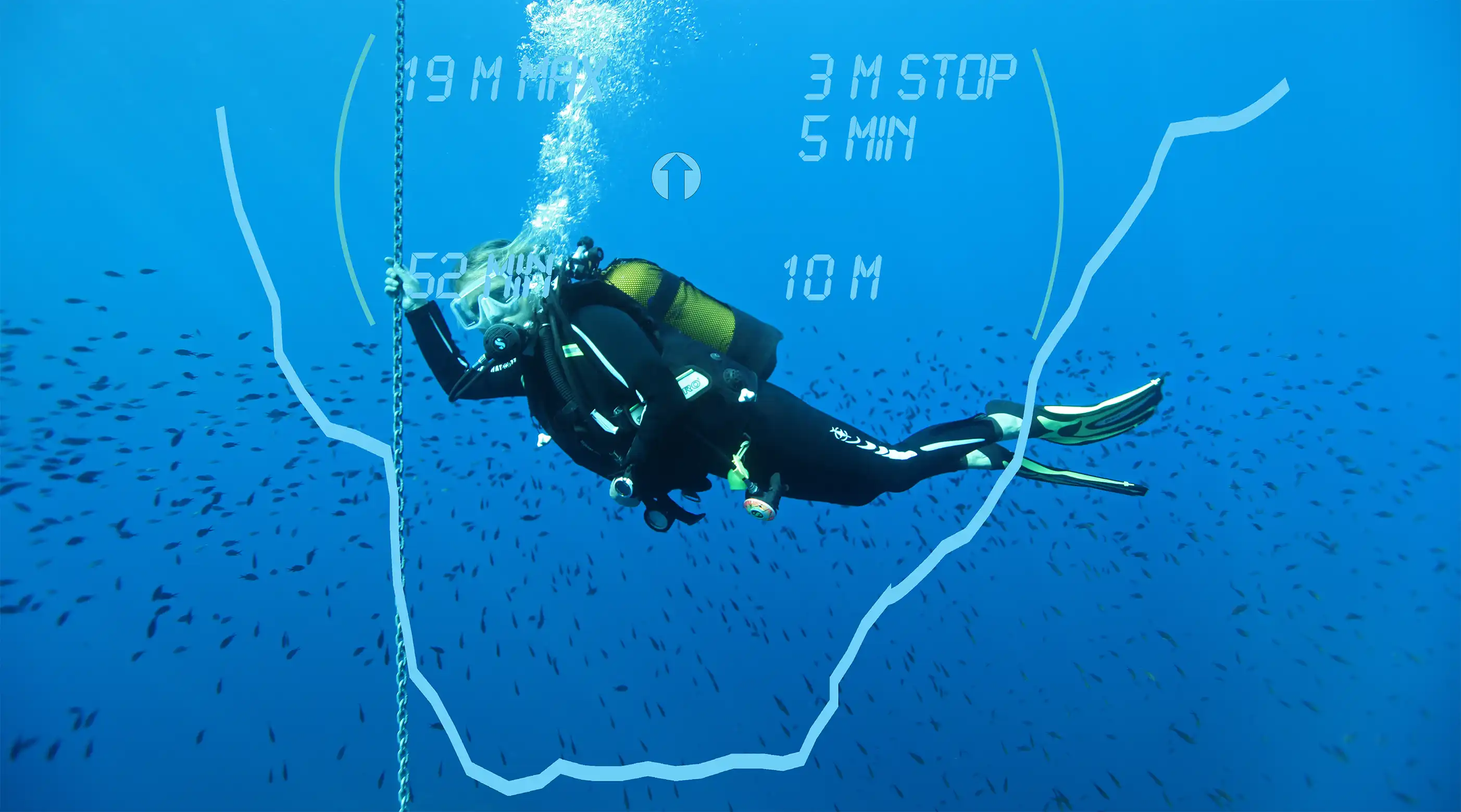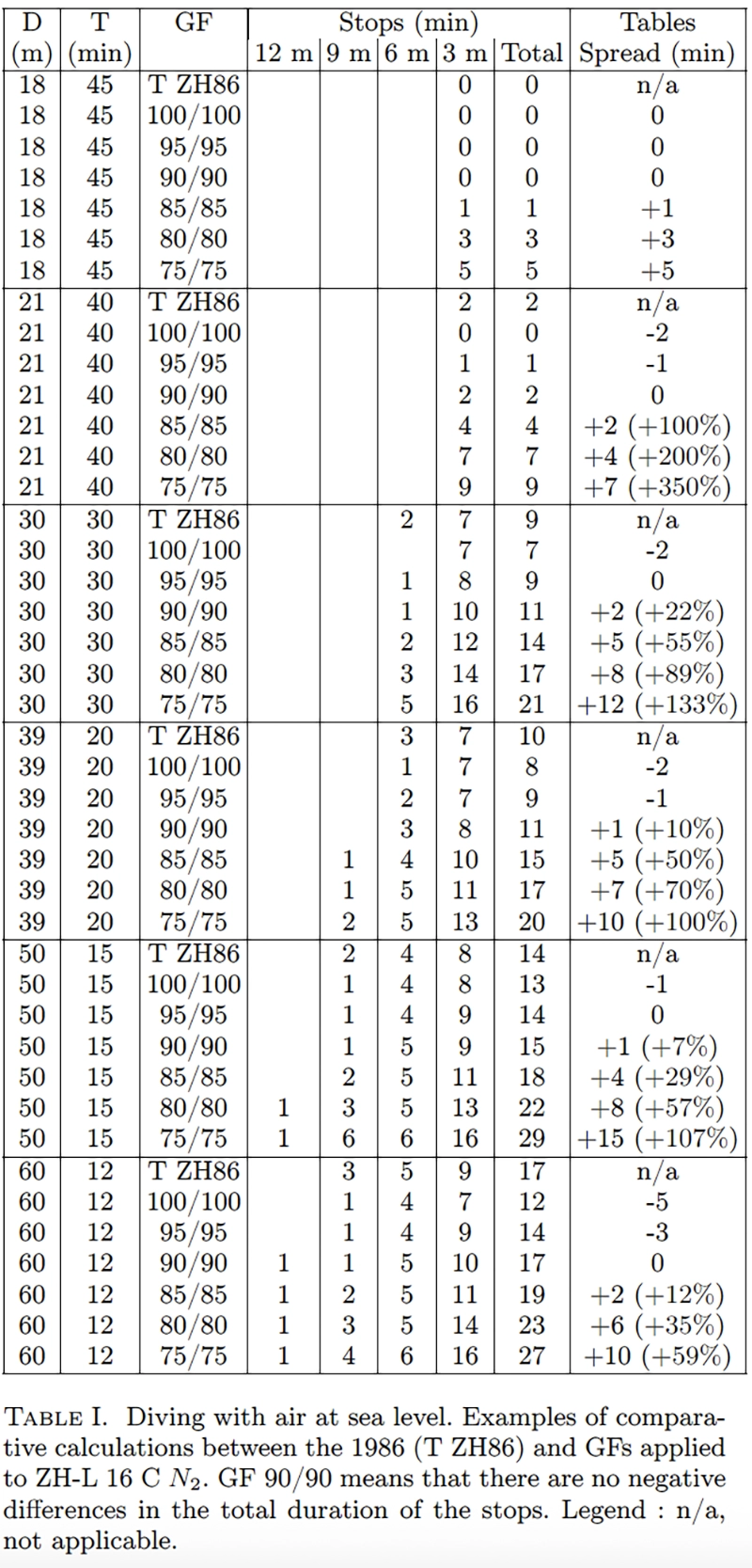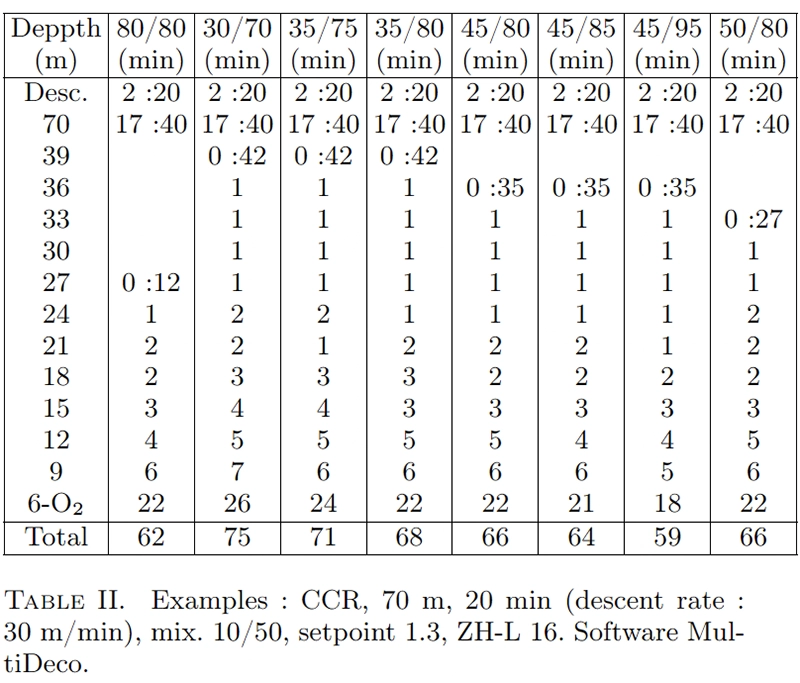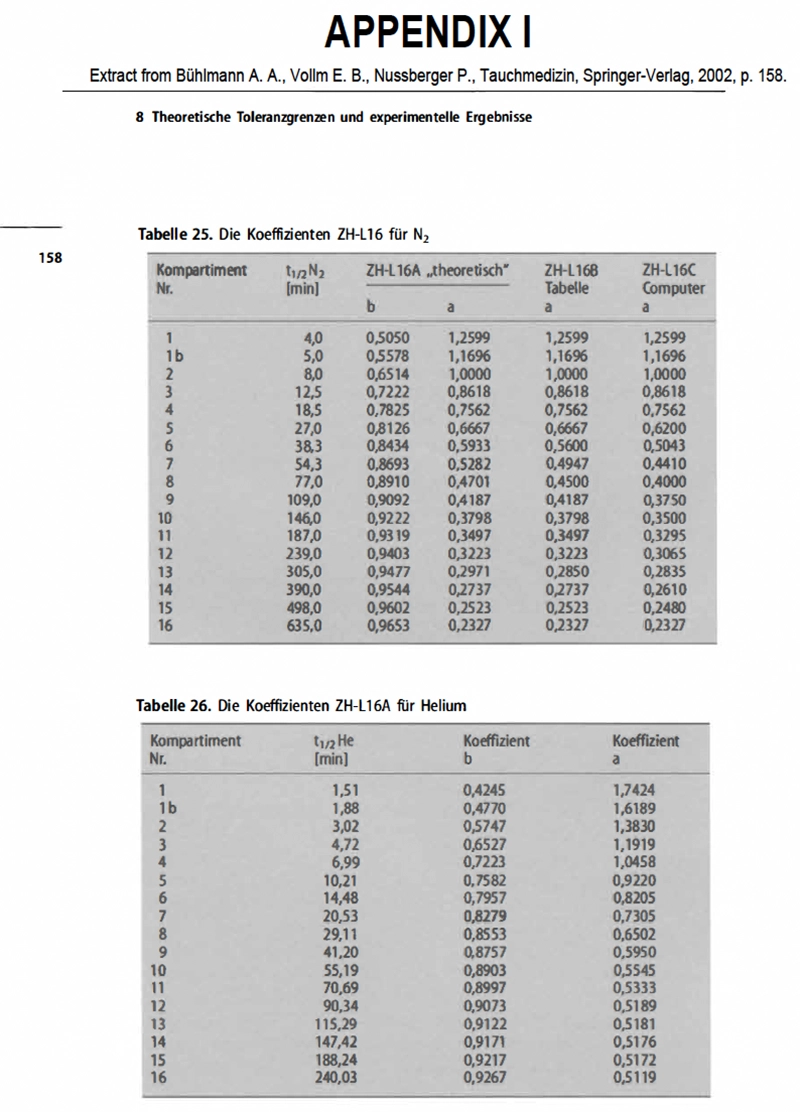Gradient Factors (GF) and dive computers

CMAS recommendations
- Air/nitrox: GFlow=GFhigh=between 90 and 80% (e.g. 90/90; 85/85; 80/80).
- Helium (heliox, trimix): GFlow between 30 and 50, GFhigh between 70 and 80 (e.g. 50/80; 30/70).
GFs are one means of DCS risk prevention, among others. They are, by definition, arbitrary and offer no guarantee.
Disclaimer
Abstract
In other words, they reduce, in Workman’s notation*, the M0 and ΔM values of the set of parameters.
The choice of GFs is arbitrary.
This raises the question of the validity of the values chosen.
''100/100' means that you are using the exact M-Values provided by the creator of the set of parameters (e.g. Bühlmann).
''90/90' means that you reduce the M-values predicted by the set of parameters (e.g. Bühlmann) by 10%.
* The same applies to all M-Values notations, including the Bühlmann notation with its a and b coefficients. All M-Values notations are compatible with each other.
Introduction
The method goes back to Bruce Wienke [2] who noticed that applying a Reduction Factor (RF) to M-Values gave similar results to those of the complex calculations of his bubble growth approach: RGBM (Reduced Gradient Bubble Model).
"Reduction factors (RF) are a published
set of M-value multipliers
to mimic bubble models".
Bruce R. Wienke and Timothy R O Leary [2]
Erik C. Baker [3] developed this approach under the name of Gradient Factors (GF), for use in technical helium diving distinguishing between two reduction factors:
- GFlow to reduce the M-Values of the first (deepest) stop ;
- GFhigh to reduce the M-Values of the last stop (closest to the surface).
GFs can therefore be used :
- or as a single reduction factor by assigning the same value to both GFs (e.g. 90/90), mainly for nitrogen dives (air, nitrox) ;
- or as a reduction factor applied differently depending on the depth of the stops (e.g. 50/80, 30/70), for helium dives (heliox, trimix).
1. Nitrogen dives (air, nitrox)
For air or nitrox dives, the set of Haldane parameters most commonly implemented in computers is that of A. A. Bühlmann, published in 1986 [4] (see Appendix I at the end of this page).
The designation is:
- "ZH" for Zurich;
- "L" for linear;
- "16" to indicate the number of different pairs of coefficients a et b (M-Values) [5];
- "A, B ou C" to characterise the version of the set of parameters;
- N2 to indicate that it concerns a nitrogen-based mixture (air, nitrox).
Based on this set of parameters, Bühlmann [6] manually reduced the values of a for the 38.3, 54.3 and 77 min compartments to give the ZH-L16 B parameter set (N2) for publication in printed tables.
He then reduced the a values for the compartments from 27 to 498 min, the safety margin being smaller with a computer (actual diver profile) than with tables (square profile). The set of parameters ZH-L 16 C (N2) is intended for use with dive computers [7].
Nearly 40 years’ experience of its use have shown it to be reliable.
1.1 Justifying the use of GFs (air, nitrox)
There are two reasons for using GFs for air or nitrox dives:
- Add a safety margin due to the calculation of dive computers, which takes into account as closely as possible the real profile of the diver and not a "square profile" like the dive tables (moreover, Bühlmann had taken a safety margin of +1 m in his tables [8]);
- Increasing the duration of the stops (or decreasing the No Stops Limits) due to risk factors (age, obesity, fatigue, effort...).
1.2 Increasing the duration of mandatory stops or reducing the duration without stops: a common and long-standing practice
Throughout the history of diving, the need to extend the duration of stops beyond that suggested by the desaturation method has always arisen, particularly during underwater efforts (work, current).
For tables, the rule is:
- or increase the dive time, by taking a longer dive time than the one actually completed (e.g. for a 30-minute dive, take 35 or 40 minutes) ;
- or to increase the depth.
For no-stop dives, the approach was to reduce the nostop time limit. For example, "the NAUI (1990) Dive Tables are modified U.S. Navy Tables. Instead of the U.S. Navy NDLs, the NAUI Tables utilize Maximum Dive Times (MDTs) which are, in fact, the U.S.Navy NDLs reduced by one letter group for dives between 60 feet and 130 feet; by two groups for 50-foot dives; and three groups for 40-foot dives" [10].
Using the same logic as the tables, the use of GFs for air or nitrox dives allows a safety factor to be applied with dive computers.
1.3 GFlow smaller than GFhigh : unsuitable with nitrogen (air, nitrox)
Using GFlow smaller than GFhigh (e. g. 40/85, 30/70) forces you to make deep stops, which, with air or nitrox, increases the risk of DCS.
This was revealed by the French Navy in 2005 [11] and confirmed by the U.S. Navy in 2011 [12].
Even for shallow dives, this practice is not recommended [13].
Consequently, when diving with air or nitrox, it is advisable to use only GFlow equal to GFhigh.
1.4 No-stop dives
For no-stop dives, the time limits at different depths are determined solely by the surface M-Values (M0 in Workman notation).
In other words, only GFhigh is used.
Consequently, setting different GFs may mislead uninformed divers into believing that they are applying a high safety factor by assigning a low value to GFlow, despite the fact that GFlow is not used.
So, for no-stop dives :
- GFs set at 45/95 are equivalent to 95/95 ;
- GFs set at 40/85 are equivalent to 85/85 ;
- GFs set at 35/80 are equivalent to 80/80 ;
- and so on.
1.5 Fixing GFs for air or nitrox dives
TABLE I

Then there is the attempt to take account of individual risk factors (age > 40 and even more so from the age of 60 [15] [16], obesity, fatigue...) or environmental factors (exertion, cold, poor diving conditions, etc.). There are many ways of doing this (the list is not exhaustive) :
- undergo a medical check-up every year to ensure that your health is compatible with scuba diving, which, according to some studies, reduces the risk of accident by 2.5 [17];
- stay in good shape;
- take a physiological break (rest, sleep, healthy lifestyle) before diving;
- make rehabilitation dives after 15 to 30 days without diving, increasing the depth and duration only gradually (e.g. 20 m, then 30 m, then 40 m, then 50 m...) [18];
- make pure oxygen stops at 6 m;
- dive using nitrox;
- make only one dive a day;
- avoid risky profiles (rapid ascent, yo-yo, sawtooth);
- reduce the duration and/or depth of the dive;
- respect a Surface Interval (SI) of at least 2 to 3 hours between two dives, or even 3 to 4 hours in the case of dives with mandatory stops;
- increase the stops duration, either by yourself (e.g. staying in the 3-6 m zone at the end of the dive, even without stops indicated by the computer), or by reducing the GF.
Depending on the risk prevention measures implemented (see list above), the choice of GF with nitrogen (air, nitrox) is generally:
- 90/90 (no risk factors) ;
- 85/85 ;
- 80/80.
Lower GFs (e.g. 75/75 or 70/70) could be considered in the case of major risk factors, but in recreational diving this would raise the question of whether you still want to dive that day. In other words, it is understandable to increase the stop duration by a few minutes (one or two groups with tables ; GF 90/90 or 85/85 or even 80/80 with a computer), but it seems inconsistent to exaggerate this increase (it would probably be better not to dive).
In this context, Emmanuel Dugrenot and Joël Galien signed their names with their positions at IANTD at the time : "For an air or nitrox dive, you can use a pure Bühlmann profile or use GF 80/80s if you’re doing a committed dive"[19].
Albi Salm (Sub Marine Consulting) has also shown that the L0 mode of the Galileo 2 (G2) Scubapro/Uwatec was set to 90/90 in software version 1.2 and 85/85 in version 1.5 [20].
Finally, a 2025 publication from LIFRAS (Belgium) [21], indicates : « Recommendation: set the GFs identically and to values of minimum 85% and maximum 90%. GFlow = GFhigh = between 85% and 90%. »
In summary, for nitrogen dives (air, nitrox), it is advisable to apply GFs of at least 90/90 and, depending on the risk factors, to lower them to 85/85 (or even 80/80).
In all cases, the choice of GF should be shared with the members of the team before diving and accepted by all.
1.6 Implementation in dive computers
GFs have been used in computers for over 30 years.
Depending on the computer, GFs are:
- pre-set ;
- left free for the user to enter (sometimes with proposals for predefined GF).
1.6.1 Preset GFs
GF presets have been implemented for many years in virtually all computers (air, nitrox), via the "Customisation", "P Factor", "Caution factor", "Safety factor", "Safety factor level", "Conservatism" or other modes:
- L0, L1, L2. . . (Scubapro);
- MBL0, MBL1, MBL2. . . (Scubapro);
- P0, P1, P2. . . (Suunto);
- R0, R1, R2. . . (Mares);
- SF0, SF1, SF2. . . (Cressi sub, Tusa);
- SFT LEV (Seac);
- ...
The GFs are fixed at a given value in "0" mode (e.g. 90/90) and decrement when the parameter setting is changed (option "1", "2", etc.). Lowering the GFs (e.g. 85/85 ; 80/80) makes desaturation more conservative (longer stops or shorter time without stops - shorter No-Stop Limits).
1.6.2 Free entry of GFs
Some computer models allow free entry of GFs, with "securities" that vary according to the machine (e. g. GFlow less than or equal to GFhigh ; GF capped at 99%...).
Some manufacturers propose predefined GF settings, while others leave the choice up to the diver. For example :
- Shearwater (Teric, Peregrine...) : 45/95 ; 40/85 ; 35/75 or personalised.
- Garmin : 45/95 ; 40/85 ; 35/75 or personalised.
- Apeks (DSX, mode sport) : 90/90 ; 35/80 ; 30/70 or personalised.
- Suunto (Ocean) : 45/80 by default or personalised.
- Scubapro (G2 Tek, G3, HUD, LUNA 2.0) : « Gradient Factors can be set from no conservatism at all (100/100) to many different combinations. ».
Source : Manufacturers’ user manuals.
1.6.3 GF by default, factory setting
This point should be checked according to the type of dive in order to adapt the choice of GFs.
2. Helium dives (heliox, trimix)
Bühlmann’s "helium" set of parameters was published at the same time as the three "nitrogen" sets of parameters mentioned above.
This is the set "ZH-L 16 A He". By the way, manufacturers providing a "Bühlmann helium" option should not write in their instructions that it is "ZH-L 16 C". This creates confusion between one set of parameters validated for computers (nitrogen, C) and another set of parameters (helium, A).
"ZH-L 16 C N2" only applies to nitrogen (nitrox air).
For helium, it is "ZH-L 16 A He". These two sets of parameters are presented as follows on page 158 of the book by Bühlmann (see Appendix I).
This helium set of parameters was published in the 1980s and was designed several years earlier. However, the helium desaturation methods used at the time have evolved. In particular with the work of Comex [22] which led to the world depth record at -701 m (Hydra X, Théo Mavrostomos, 1992).
"Xavier Fructus and Christian Agaraté developed the first helium decompression tables for commercial divers (Cx 67, Cx 70, Cx 71). These tables were subsequently constantly improved and became the official French Ministry of Labour decompression tables (MT 74 and MT 92)".
It has been shown that, when diving with helium, short, very deep stops (1 min) should be made (half the depth or more), in order to reduce the risk of bends and DCS of the inner ear (and, in the long term, the risk of dysbaric osteonecrosis).
However, the parameter set "ZH-L 16 A He" does not intrinsically give this type of decompression profile.
Consequently, in the absence of another set of parameters [23], it was decided to apply GFs in order to "force" deep stops by reducing the GFlow, of the 50/80 type or 30/70.
Some dive computer manufacturers suggest other predefined values such as 45/95, 45/85, 45/80, 35/75 or 35/80. None of them justify their choices, all of them refer to the individual responsibility of divers.
TABLE II

Conclusion
For nitrogen dives (air, nitrox), the Bühlmann set of parameters has been tried and tested for many years. It is advisable to use GFs set at least at 90/90 and lowered to 85/85 (or even 80/80) in the case of risk factors, given that GFs are one of many ways of reducing the risk of DCS.
For helium dives (heliox, trimix), with the Bühlmann set of He parameters, GFs should be applied in order to force deep stops (to reduce the risk of bends, DCS of the inner ear and, in the long term, the risk of dysbaric osteonecrosis). Each community of deep divers has developed its own habits and choices. A safe approach seems to argue in favour of GF 30/70, particularly for committed dives.

[1] Andre S, Lehot H, Morin J, et al., Influence of prehospital management on the outcome of spinal cord decompression sickness in scuba divers, Emerg Med J Epub, feb 2022, doi :10.1136/emermed-2021-211227.
[2] Bruce R. Wienke, Timothy R O Leary, On modern dive computers and operation protocols, models, tests, data, risk and applications, 2017, DOI : 10.13140 RG.2.2.19163.26404. « Reduction factors (RF) are a published set of M-value multipliers to mimic bubble models »
[3] Erik C. Baker, Understanding M-Values.
[4] Bühlmann A. A., Vollm E. B., Nussberger P., Tauchmedizin, Springer-Verlag, 2002, p. 162.
[5] Not the number of compartments : Bühlmann A. A., Vollm E. B., Nussberger P., Tauchmedizin, Springer-Verlag, 2002, p. 128.
[6] Bühlmann A. A., Vollm E. B., Nussberger P., Tauchmedizin, Springer-Verlag, 2002, pp. 129-159.
[7] ZH-L 16 C ‘GF’ mentioned in some dive computers is not a specific set of parameters, it is just ZH-L 16 C with the possibility of manually modifying the GF.
[8] Bühlmann A. A., Vollm E. B., Nussberger P., Tauchmedizin, Springer-Verlag, 2002, p. 165.
[9] Shields T. G. et Lee W. B., The incidence of decompression sickness arising from commercial offshore airdiving operations in the UK sector of the North Sea during 1982/83, United Kingdom, 1997, p.25.
[10] Lippmann J., The essentials of deeper sport diving, Aqua Quest Publications, inc. New York, 1992, pp. 135-148.
[11] Blatteau J.-E., Hugon M., Gardette B., Galland F.-M., Bubble incidence after staged decompression from 50 or 60 msw: effect of adding deep stops, Bulletin de médecine subaquatique et hyperbare, Aviation Space Environmental Medicine, 2005 ; 76 :490–2.
[12] Doolette D.J., Gerth W.A., Gault K.A., Redistribution of decompression stop time from shallow to deep stops increases incidence of decompression sickness in air decompression dives, Navy Experimental Diving Unit (NEDU), 2011.
[13] Nico A.M. Schellart, Jan-Jaap Brandt Corstius, Peter Germonpré, and Wouter Sterk, Bubble Formation After a 20-m Dive : Deep-Stop vs. Shallow-Stop Decompression Profiles, Aviation, Space, and Environmental Medicine x Vol. 79, No. 5 x May 2008.
[14] Bühlmann A. A., Vollm E. B., Nussberger P., Tauchmedizin, Springer-Verlag, 2002, p. 165.
[15] Schellart NA, Vellinga TP, van Dijk FJ, Sterk W., Doppler bubble grades after diving and relevance of body fat, Aviat Space Environ Med. 2012 Oct ;83(10) :951-7. doi : 10.3357/asem.3189.2012. PMID : 23066616.
[16] Ran Arieli et Abraham Marmur, A biophysical vascular bubble model for devising decompression procedures, Physiol Rep, 5 (6), 2017, e13191, doi : 10.14814/phy2.13191.
[17] R. Cali-Carleo, 6e conférence de consensus de l’ECHM (European Committee for Hyperbaric Medicine), Genève, 2003.
[18] Foret A., Plongée Plaisir 4, 12e édition, Éditions GAP, 2025, p. 256.
[19] E. Dugrenot, J. Galien, Quel Trimix pour quelle plongée : exemples et explications de protocoles.
[20] Albi Salm, Scubapro/Uwatec Galileo 2/G2 MB Levels Vs Gradient Factors, Sub Marine Consulting, 2020. https://www.divetable.info/skripte/G2_GF.pdf.
[21] Ma déco, Lifras, 2025 (https://www.lifras.be/madeco.aspx).
[22] B. Gardette et M. Plutarque, Comex, 50 ans de recherches et d’innovations, CACX, 2012.
[23] The VP2 model proposed by Bernard Gardette could offer an alternative. B. Gardette et M. Plutarque, Comex, 50 ans derecherches et d’innovations, CACX, 2012, pp. 136-137.









